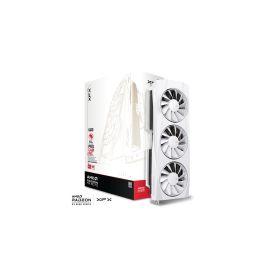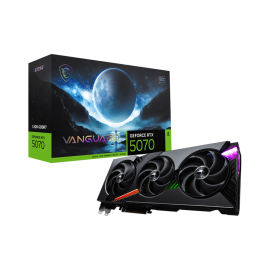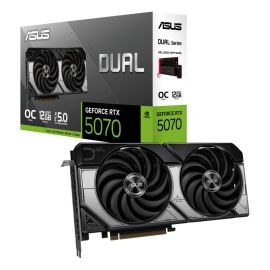-
MSI GeForce RTX 5070 12G VANGUARD SOC Launch Edition Graphics Card, 12GB GDDR7, Blackwell Architecture, DLSS 4, HYPER FROZR Cooling, PCIe 5.0, RGB Lighting
Special Price BHD 341.16 was BHD 408.23 -
PNY GeForce RTX 5070 OC Triple‑Fan 12GB GDDR7 Graphics Card – PCIe 5.0, Blackwell Architecture, 6,144 CUDA Cores, Factory Overclocked (Boost up to 2,587 MHz
Special Price BHD 305.61 was BHD 339.62
Gaming Graphic Cards
The most powerful hearts of any high-performance gaming PC are the gaming graphic cards that produce amazing frame rates, mind-blowing visual ability, and record-breaking gameplay bites. The pace of development of the gaming industry is so rapid that even the modern gaming GPUs are capable of providing support to the latest releases with the highest technologies, including the real-time ray tracing, AI-enhanced upscaling technology, and powerful cooling systems. Regardless of being a casual gamer, competitor in esports, or a professional streamer, the choice of the graphic card used in gaming can make a significant contribution to performance maximization, latency minimization, and streamlining gameplay at every resolution between 1080p and 4K and above.
The best graphic cards in the year 2025 are the flagship models provided by popular brands (NVIDIA and AMD) with such variants as the NVIDIA GeForce RTX 4090, RTX 4080 Super, and AMD Radeon RX 7900 XTX, RX 7800 XT. These GPUs are designed using high-powered architectures, the Ada Lovelace by NVIDIA, and the RDNA 3 by AMD which offers significant power efficiency, around-up ray tracing performance, and shader throughput. Their superior VRAM settings, up to 24GB GDDR6X memory make it possible so that the gamer could use textures packs and complicated gameplays without sacrificing speed or high definition.
Existing GPU games now have vital features such as DLSS 3.5 and the FidelityFX Super Resolution (FSR 3) by AMD: those are AI-driven technologies that upscale reduced-resolution frames to new ones, adding sharpness and clarity. It greatly increases the frame rates making competitive games run at high refresh rate of 144Hz or 240Hz monitors with support of brilliant visual sharpness. Also, the usage of ray tracing is used to improve the lighting, reflections, and shadows in a game like Cyberpunk 2077, Call of Duty: Warzone, Fortnite to implement cinematic and realistic graphics.
The use of low latency features such as NVIDIA Reflex or AMD Anti-Lag has seen it included as common feature in graphic cards used in gaming platforms to specifically reduce input lag and the time it takes to respond to a command. These enhancements are essential in terms of gameplay in action games, MOBA and battle royales to provide gamers with an invaluable advantage. When used together with high-performance CPUs and supported by such capabilities as the G-SYNC or FreeSync compatible displays, gaming graphic cards can provide gamers with smooth and tear-free experience.
The important aspects in terms of gaming graphics cards are thermal performance and cooling. Triple-fan design, vapor chamber, and big heatsinks are used in most high-end models in order to keep it within the desired operating temperatures during prolonged operation. ASUS ROG Strix, MSI Gaming X Trio, Gigabyte AORUS, and Sapphire Nitro+ are the brands that provide custom cooling equipment, having RGB lighting, silent idle fan stop, and structural strengthening backplates. The effective cooling does not only boost its performance by avoiding thermal throttling but it also increases the life of the card.
Connectivity options of gaming graphic cards have improved too with support of PCIe 4.0 and new PCIe 5.0 standards, providing the maximum bandwidth of data transfer between GPU and CPU. There are several DisplayPort 1.4a connections and high-resolution and refresh rate connections HDMI 2.1, supporting multi-monitor scenarios and large screens (4K, 8K). The ability to be connected flexibly is important to the gamer with ultrawide screens, VR headsets, or streaming installations, which have multiple outputs.
The functionality of streaming and content developing software makes the gaming graphic cards more frugal. NVidia NVENC and AMD VCE are hardware encoders so gamers can stream game at 4K quality at minimal CPU footprint, easier to whether at twitch and YouTube. Streamers and content creators are further assisted by software packages such as NVIDIA Broadcast with AI-based capabilities to lower background noise, improve webcam quality and use a virtual background.
The power needs and birthmarks forms among the gaming graphic cards differ largely. High-end GPUs, such as the RTX 4090 and of the enthusiast quality, need spacious cases with good airflow, powerful power supplies (usually 850W or more) and cooling. In the meantime, the RTX 4070 Ti, RTX 4060 Ti, and Radeon RX 7600 offer mid range selections, in smaller form factors with a lesser power requirement, yet capable of 1080p through 1440p gaming smoothly. It is important to learn these factors because it helps in the creation of balanced systems that are free of bottlenecks and over-heating.
Customisable functionality Gaming graphic cards also come with user-tunable overclocking from the factory, user-controllable fan curves and gamers control the lighting effects via the RGB lighting. Enthusiasts can use such utilities as MSI Afterburner, ASUS GPU Tweak, and Gigabyte RGB Fusion to keep their GPU overclocked safer than its stock form. These tuning options have the ability of increasing the frame rate, minimizing power consumption, and adding lighting effects to the system which are synchronized with the other components of the PC.
Although history, multi-GPU configurations devote less interest in the present, they are available to users that need to plug in the highest graphical performance. Several technologies, like NVIDIA SLI and AMD CrossFire, can permit two or more permissible graphics processors to be interconnected in order to augment rendering processing. Nevertheless, with increased efficiency and software update, the attention has moved to single powerful GPUs and multi-GPU set ups are primarily employed just in advanced professional and research uses.
Gaming graphic cards are also enhanced in terms of virtual reality (VR) and augmented reality (AR) play. Their high frame rates and low latency allow delivering immersive performance with a low degree of motion sickness due to support of OpenXR and SteamVR standards. The most popular GPUs such as RTX 4080 and RX 7900 XT allow delivering the required performance to power high-resolution VR headsets and demanding AR applications.
In the future, the possibilities of graphic cards in gaming keep increasing along with the tendencies of game developments, including cloud gaming, the involvement of AI graphics, and ray tracing improvements. The combination of AI accelerator, tensor core, and other shading technologies will move the interfaces towards realism and interactivity. Keeping up with new graphics cards and drive updates is crucial to gamers who want to compete on the same level and present high-quality graphic effects.
In brief, the playing graphic cards are the fundamentals of immersive, high-fidelity, and competitive gaming experiences in the world. They are a blend of ample powerful, intelligent features, cooling technology, and software support, without which a contemporary gamer cannot afford to do without. To use ultra settings on the latest AAA games, play competitively in esports, or achieve high-quality streaming devoid of any issues, performance and reliability never can be matched with the right gaming graphic card.
Chat With Us
- Guest Chat
- Login Chat




































